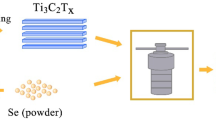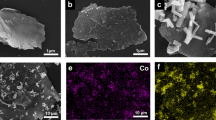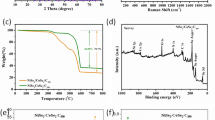Abstract
FeS2/CoS and FeS2/CoS/C composites were synthesized by solvothermal method and following vapor phase vulcanization at mild temperature with binary oxide CoFe2O4 as precursors. All FeS2/CoS composites prepared at different molar ratios of Fe3+ and Co2+ ions exhibit the similar morphology of solid microspheres. As anode materials for lithium-ion batteries (LIBs), the as-prepared FeS2/CoS and FeS2/CoS/C composites show higher reversible capacity and better cycling performance, compared with the bare FeS2 and CoS. Among them, the FeS2/CoS composite with molar ratio of Fe3+ and Co2+ of 2:1 exhibits the high reversible capacity of 1150 mAh g−1 after 100 cycles at 100 mA g−1 and even 610 mAh g−1 at 1.0 A g−1 after 900 cycles. This strategy for synthesizing the heterogeneous structure of binary sulfide can effectively improve the kinetic which thus enhance the electrochemical performance of materials. This work can provide an effective method and idea for the preparation and modification of FeS2 and other transition metal sulfide anode materials for LIBs in the future.






Similar content being viewed by others
References
Li W, Gong Z, Yan X, Wang D, Liu J, Guo X, Li G (2020) In situ engineered ZnS–FeS heterostructures in N-doped carbon nanocages accelerating polysulfide redox kinetics for lithium sulfur batteries. J Mater Chem A 8(1):433–442
Xu QT, Xue HG, Guo SP (2018) FeS2 walnut-like microspheres wrapped with rGO as anode material for high-capacity and long-cycle lithium-ion batteries. Electrochim Acta 292:1–9
Yang T, Fang MJ, Liu JW, Yang DX, Liang YH, Zhong JS, Guo Z (2022) Ultra-narrow bandgap Se-deficient bimetallic selenides for high performance alkali metal-ion batteries. Adv Funct Mater 32(39):2205880
An SJ, Li J, Daniel C, Mohanty D, Nagpure S, Wood III (2016) The state of understanding of the lithium-ion-battery graphite solid electrolyte interphase (SEI) and its relationship to formation cycling. Carbon 105:52–76
Guo SP, Li JC, Xiao JR, Xue HG (2017) Fe3S4 nanoparticles wrapped in an rGO matrix for promising energy storage: outstanding cyclic and rate performance ACS Appl Mater Interfaces 9:37694–37701
Wu X, Yang X, Zhang F, Cai L, Zhang L, Wen Z (2017) Carbon-coated isotropic natural graphite spheres as anode material for lithium-ion batteries. Ceram Int 43(12):9458–9464
Xu QT, Li JC, Xue HG, Guo SP (2018) Binary iron sulfides as anode materials for rechargeable batteries: crystal structures, syntheses, and electrochemical performance. J Power Sources 379:41–52
Zhang Y, Zhou Q, Zhu J, Yan Q, Dou SX, Sun W (2017) Nanostructured metal chalcogenides for energy storage and electrocatalysis. Adv Funct Mater 27(35):1702317
Mao CM, Xu XX, Wang SW, Zhang ZH, Li GC (2020) Mass production of porous Fe3O4 nanoparticle networks wrapped with ultrathin nitrogen-doped carbon for superior lithium ion batteries. Appl Surf Sci 505:144525
Xu QT, Li JC, Xue HG, Guo SP (2018) Effective combination of FeS2 microspheres and Fe3S4 microcubes with rGO as anode material for high-capacity and long-cycle lithium-ion batteries. J Power Sources 396:675–682
Yang T, Zhong JS, Liu JW, Yuan YJ, Yang DX, Mao QN, Guo Z (2021) A general strategy for antimony-based alloy nanocomposite embedded in Swiss-cheese-like nitrogen-doped porous carbon for energy storage. Adv Funct Mater 31:202009433
Yang T, Liu YG, Yang DX, Deng BB, Huang ZH, Ling CD, Zheng R (2019) Bimetallic metal-organic frameworks derived Ni-Co-Se@C hierarchical bundle-like nanostructures with high-rate pseudocapacitive lithium ion storage. Energy Storage Mater 17:374–384
Xu QT, Xue HG, Guo SP (2018) Facile preparation of FeS@GO and its outstanding electrochemical performances for lithium storage. Inorg Chem Front 5:2540–2545
He J, Li Q, Chen Y, Xu C, Zhou K, Wang X, Li Y (2017) Self-assembled cauliflower-like FeS2 anchored into graphene foam as free-standing anode for high-performance lithium-ion batteries. Carbon 114:111–116
Wang Q, Zou R, Xia W, Ma J, Qiu B, Mahmood A, Xu Q (2015) Facile synthesis of ultrasmall CoS2 nanoparticles within thin N-doped porous carbon shell for high performance lithium-ion batteries. Small 11:2511–2517
Li Q, Chen Y, He J, Fu F, Lin J, Zhang W (2016) Three-dimensional VS4/graphene hierarchical architecture as high-capacity anode for lithium-ion batteries. J Alloy Compd 685:294–299
Zhao Y, Li X, Yan B, Xiong D, Li D, Lawes S (2016) Recent developments and understanding of novel mixed transition-metal oxides as anodes in lithium ion batteries. Adv Energy Mater 6(8):1502175
Wu J, Lau WM, Geng DS (2017) Recent progress in cobalt-based compounds as high-performance anode materials for lithium ion batteries. Rare Met 36(5):307–320
Wang H, Ma J, Liu S, Nie L, Chai Y, Yang X (2016) CoS/CNTs hybrid structure for improved performance lithium ion battery. J Alloy Comp 676:551–556
Fu F, Chen Y, Li P, He J, Wang Z, Lin W, Zhang W (2015) Three-dimensional CoS2/RGO hierarchical architecture as superior-capability anode for lithium ion batteries. Rsc Adv 5(88):71790–71795
Wang X, He J, Zheng B, Zhang W, Chen Y (2018) Few-layered WSe2 in-situ grown on graphene nanosheets as efficient anode for lithium-ion batteries. Electrochim Acta 283:1660–1667
Xue H, Denis YW, Qing J, Yang X, Xu J, Li Z, Lee CS (2015) Pyrite FeS2 microspheres wrapped by reduced graphene oxide as high-performance lithium-ion battery anodes. J Mater Chem A 15:7945–7949
Zhu J, Jin M, Tang S (2019) Fabrication of cobalt sulfide/graphene sheets nanocomposite harvesting improved anode performance for lithium-ion battery. J Nanosci 19(9):5921–5927
Yersak TA, Macpherson HA, Kim SC, Le VD, Kang CS, Son SB, Lee SH (2013) Solid state enabled reversible four electron storage. Adv Energy Mater 3:120–127
Li X, Qi SH, Zhang WC, Feng YZ, Ma JM (2020) Recent progress on FeS2 as anodes for metal-ion batteries. Rare Met 39(11):1239–1255
Xu X, Li L, Chen H, Guo X, Zhang Z, Liu J, Li G (2020) Constructing heterostructured FeS2/CuS nanospheres as high rate performance lithium ion battery anodes. Inorg Chem Front 7(9):1900–1908
Wang X, Wang B, Yang J, Ran Q, Zou J, Chen P, Niu X (2021) In situ formed FeS2@CoS cathode for long cycling life lithium-ion battery. Chin Phys B 30(8):088201
Ashby DS, Horner JS, Whang G, Lapp AS, Roberts SA, Dunn B, Talin AA (2022) Understanding the electrochemical performance of FeS2 conversion cathodes. ACS Appl Mater Interfaces 14(23):26604–26611
Zhang F, Wang C, Huang G, Yin D, Wang L (2016) FeS2@C nanowires derived from organic-inorganic hybrid nanowires for high-rate and long-life lithium-ion batteries. J Power Source 328:56–64
Li H, Zhu W, Yang J, Zhang M, Zhao J, Qu W (2018) Sulfur abundant S/FeS2 for efficient removal of mercury from coalfired power plants. Fuel 232:476–484
Li W, Chen Z, Wang D, Gong Z, Mao C, Liu J, Li G (2019) Reliable and valid pyrite electrocatalysts supported on nitrogen-doped porous carbon sheets for advanced lithium sulfur batteries. J Power Source 435:226778
Li Y, Yin J, An L, Lu M, Sun K, Zhao YQ, Xi P (2018) FeS2/CoS2 interface nanosheets as efficient bifunctional electrocatalyst for overall water splitting. Small 14(26):1801070
Zhang Y, Zhang Z, Zhang Y, Wang P, Han P, Li K, Liu W (2021) Preparation of a sulfur-doped graphene-wrapped FeS2 microsphere composite material for lithium-ion batteries. Energy Fuels 35(24):20330–20338
Miao W, Zhang Y, Li H, Zhang Z, Li L, Yu Z, Zhang W (2019) ZIF-8/ZIF-67-derived 3D amorphous carbon-encapsulated CoS/NCNTs supported on CoS-coated carbon nanofibers as an advanced potassium-ion battery anode. J Mater Chem A 7(10):5504–5512
Kong S, Jin Z, Liu H, Wang Y (2014) Morphological effect of graphene nanosheets on ultrathin CoS nanosheets and their applications for high-performance Li-ion batteries and photocatalysis. J Phys Chem C 118(44):25355–25364
Jia Y, Cheng A, Ke W, Liu J, Wang S, Zhao Y, Zhang J (2021) Hierarchical structure constructed by manganese oxalate framework with accurate iron doping for ultra-efficient lithium storage. Electrochim Acta 380:138217
Fan HH, Li HH, Huang KC, Fan CY, Zhang XY, Wu XL, Zhang JP (2017) Metastable marcasite-FeS2 as a new anode material for lithium ion batteries: CNFs-improved lithiation/delithiation reversibility and Li-storage properties. ACS Appl Mater Inter 9(12):10708–10716
Yin W, Li W, Wang K, Chai W, Ye W, Rui Y, Tang B (2019) FeS2@porous octahedral carbon derived from metal-organic framework as a stable and high capacity anode for lithium-ion batteries. Electrochim Acta 318:673–682
Zou J, Zhao J, Wang B, Chen S, Chen P, Ran Q, Wang L (2020) Unraveling the reaction mechanism of FeS2 as a Li-ion battery cathode. ACS Appl Mater Interfaces 12:44850–44857
Wu Z, Zhang W, Xia Y (2023) A comprehensive cognition for the capacity fading mechanism of FeS2 in argyrodite-based all-solid-state lithium battery. EcoMat 5(4):e12327
Zhao P, Cui H, Luan J, Guo Z, Zhou Y, Xue H (2017) Porous FeS2 nanoparticles wrapped by reduced graphene oxide as high-performance lithium-ion battery cathodes. Mater Lett 186:62–65
Xu X, Ying H, Zhang S, Meng Z, Yan X, Han WQ (2020) Biomass-derived 3D interconnected porous carbon-encapsulated nano-FeS2 for high-performance lithium-ion batteries. ACS Appl Energy Mater 3(6):5589–5596
Wang H, Ma J, Liu S, Nie L, Chai Y, Yang X (2016) CoS/CNTs hybrid structure for improved performance lithium ion battery. J Alloy Compd 676:551–556
Lin W, Huang Y, He G (2018) Unique CoS hierarchitectures for high-performance lithium ion batteries. CrystEngComm 20(42):6727–6732
Funding
This work was financially supported by Open and Innovative Fund of Hubei Three Gorges Laboratory (No. SK211005).
Author information
Authors and Affiliations
Contributions
Yajing Fu and Ji Li: methodology, investigation, data curation, writing, original draft, visualization. Hairui Wang and Jiahao Zhang: investigation, data curation. Zhijun Ma and Qiong Yi: supervision. Shiquan Wang: writing, review and editing, supervision, funding acquisition, resources.
Corresponding authors
Ethics declarations
Conflict of interest
The authors declare no competing interests.
Additional information
Publisher's Note
Springer Nature remains neutral with regard to jurisdictional claims in published maps and institutional affiliations.
Rights and permissions
Springer Nature or its licensor (e.g. a society or other partner) holds exclusive rights to this article under a publishing agreement with the author(s) or other rightsholder(s); author self-archiving of the accepted manuscript version of this article is solely governed by the terms of such publishing agreement and applicable law.
About this article
Cite this article
Fu, Y., Li, J., Wang, H. et al. Synthesis of FeS2/CoS heterostructure microspheres as anodes for high-performance Li-ion batteries. J Solid State Electrochem 27, 2523–2531 (2023). https://doi.org/10.1007/s10008-023-05544-4
Received:
Revised:
Accepted:
Published:
Issue Date:
DOI: https://doi.org/10.1007/s10008-023-05544-4




